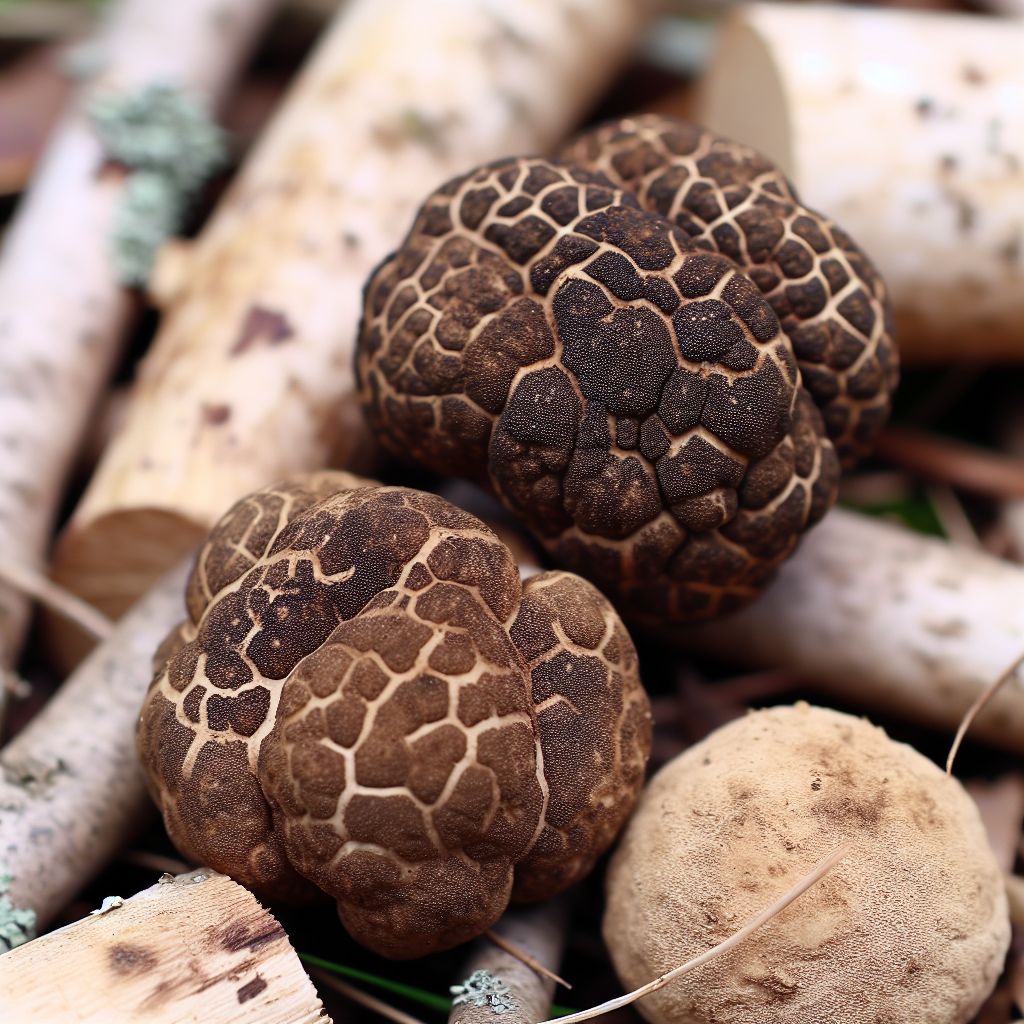Deutsch: Trüffel / Español: Trufa / Português: Trufa / Français: Truffe / Italiano: Tartufo
Truffle in the food context refers to a type of edible fungus that grows underground near the roots of certain trees. Truffles are highly prized in culinary arts for their distinctive aroma and deep, earthy flavor, which can enhance a variety of dishes from simple pastas to luxurious gourmet creations.
Description

Truffles are round, warty, and irregular in shape, and they vary in color from black to white and shades of gray and brown, depending on the species. They are typically found in woodland areas and are most commonly associated with oak and hazelnut trees. Due to their challenging cultivation and labor-intensive harvesting methods, which often require the use of trained dogs or pigs to detect their scent underground, truffles can be quite expensive.
Application Areas
Truffles are used in high cuisine to add a luxurious touch to dishes:
- As a Garnish: Thinly shaved truffles may be used to top and enhance the flavor of dishes like risottos, omelets, and pizzas.
- Infused: Truffle oil and truffle butter are popular ways to infuse the flavor of truffles into dishes without using the truffle itself, which is much more costly.
- In Sauces: Small amounts of truffle can be incorporated into sauces for pasta, steak, or poultry to impart a rich flavor.
- Specialty Dishes: Certain classic dishes rely on truffles for their characteristic flavor, such as Tournedos Rossini, a steak dish topped with truffles.
Well-Known Examples
- White Truffles from Alba: Known for their particularly aromatic quality, these truffles from the Piedmont region of Italy are among the most valued in the world.
- Black Périgord Truffles: Found in regions like France’s Dordogne, these are highly coveted for their strong flavor and are often used in pâtés and other meat dishes.
- Black Truffle Pasta: A simple yet incredibly rich dish that showcases the truffle's flavor in a creamy sauce.
Treatment and Risks
Handling and consuming truffles involve several considerations:
- Storage: Truffles lose their aroma quickly, so they are best used soon after harvesting. They should be kept in a dry, airtight container in the refrigerator to preserve their fragrance.
- Quality Control: Given their high cost, ensuring the authenticity and quality of truffles is crucial. There are many products that mimic the scent and taste of truffles but use synthetic flavors.
- Allergic Reactions: While rare, it's possible to have an allergic reaction to truffles, especially for those with sensitivities to molds and similar fungi.
- Overpowering Flavor: Truffles have a very strong taste, and overuse can overwhelm the flavors of other ingredients in a dish.
Similar Terms
- Mushrooms: While commonly lumped together with truffles, regular mushrooms grow above ground and generally have a milder flavor.
- Truffle Oil: Often used as a more affordable way to add truffle flavor to dishes, though culinary experts typically prefer to use actual truffles for a more genuine taste.
Summary
In the culinary world, a truffle is a luxurious fungus known for its robust aroma and flavor, adding depth and sophistication to dishes. They are celebrated in gourmet cooking for their ability to transform simple meals into extraordinary culinary experiences. Despite their price, the unique taste of truffles continues to make them a sought-after ingredient in high-end cuisine.
--
Related Articles to the term 'Truffle' | |
| 'A la imperiale' | ■■■■■■■■■■ |
| A la imperiale: \'in the imperial style\' a la imperiale refers to a Italian term that refers to or applied . . . Read More | |
| 'Blewit' | ■■■■■■■■■ |
| Blewit refers to a species of edible mushroom, known scientifically as Lepista nuda, that is prized for . . . Read More | |
| 'Horse Gram' | ■■■■■■■■ |
| Horse Gram refers to a small pulse (legume) that is most commonly grown as a crop in India where it is . . . Read More | |
| 'Aceite' | ■■■■■■■ |
| Aceite is the Spanish word for any kind of edible \'Oil\'. Among the Edible oils used for cooking are: . . . Read More | |
| 'Spice plant' | ■■■■■■■ |
| Spice plant refers to any plant that is grown or harvested primarily for the spices or seasonings that . . . Read More | |
| 'Clam' | ■■■■■■■ |
| Clam in the food context refers to a type of Shellfish belonging to the class Bivalvia. There are many . . . Read More | |
| 'Turnip' | ■■■■■■■ |
| Turnip in the food context refers to a root vegetable known scientifically as Brassica rapa. Part of . . . Read More | |
| 'Donut' | ■■■■■■■ |
| Donut in the food context refers to a popular sweet, deep-fried . . . . . . Read More | |
| 'Flower' | ■■■■■■■ |
| Flower in the food context refers to the edible parts of plants that are used in culinary applications. . . . Read More | |
| 'Vegetables' | ■■■■■■■ |
| Vegetables are edible plants or parts of plants that are consumed as part of a meal, primarily for their . . . Read More | |
